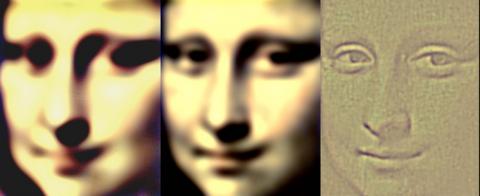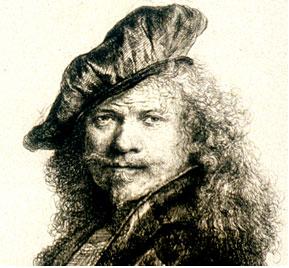A side interest in the lab is to use what we know about vision to understand some of the discoveries artists have made about how we see.
The separate processing of color and form information has a parallel in artists' idea that color and luminance play very different roles in art (Livingstone, Vision and Art, Abrams Press, 2002).
The elusive quality of the Mona Lisa's smile can be explained by the fact that her smile is almost entirely in low spatial frequencies, and so is seen best by your peripheral vision (Science, 290, 1299). These three images show her face filtered to show selectively lowest (left) low (middle) and high (right) spatial frequencies.
So when you look at her eyes or the background, you see a smile like the one on the left, or in the middle, and you think she is smiling. But when you look directly at her mouth, it looks more like the panel on the right, and her smile seems to vanish. The fact that the degree of her smile varies so much with gaze angle makes her expression dynamic, and the fact that her smile vanishes when you look directly at it, makes it seem elusive.
Here's a link to a NOVA program on the Mona Lisa that features this idea, starting around minute 38.https://www.pbs.org/video/decoding-da-vinci-93ssvo/
Here is a podcast about science and art
https://podtail.com/podcast/neuwritewest/neurotalk-special-episode-on-s…
We have been looking at depth perception in artists, because poor depth perception might be an asset in a profession where the goal is to flatten a 3-D scene onto a canvas.
We found evidence that a surprisingly large number of talented artists, including Rembrandt, might be stereoblind (Livingstone and Conway, 2004). In the etching to the left you can see that Rembrandt portrayed himself as strabismic (with misaligned eyes).
If this were the case in only one or two of his self portraits, or if he also showed other subjects with misaligned eyes, we wouldn’t think anything of it, but Rembrandt most of the time portrays himself, but not other subjects, as wall-eyed, and the outward deviating eye is reversed in his paintings compared with his etchings (think about it!)
Srihasam, K, Sullivan, KJ, Savage, T, and Livingstone, MS (2010) Non-invasive functional MRI in alert monkeys. Neuroimage, May 15;51(1):267-73. Epub 2010 Jan 29.
Freiwald WA, Tsao DY, and Livingstone MS (2009) A face feature space in the macaque temporal lobe. Nature Neuroscience 12: 1187-1196.
Libedinsky, C, Savage, T and Livingstone, M (2009) Perceptual and physiological evidence for a role for early visual areas in motion-induced blindness. Journal of Vision 9:1-10.
Tsao, DY and Livingstone, MS (2008) Mechanisms of face perception. Annual Review of Neuroscience. 31: 411-437.
Tsao, DY, Freiwald, WA, Tootell, RBH and Livingstone, MS (2006) A cortical region consisting entirely of face cells. Science,311:670-674.
Conway BR, Kitaoka, A, Yazdanbakhsh, A, Pack, CC and Livingstone MS (2005) Neural basis for a powerful static motion illusion. J. Neurosci. 25:5651-5656.
Livingstone, M.S. and Conway, B.R. (2004) Was Rembrandt Stereoblind? New England Journal of Medicine 351: 1264-1265.

